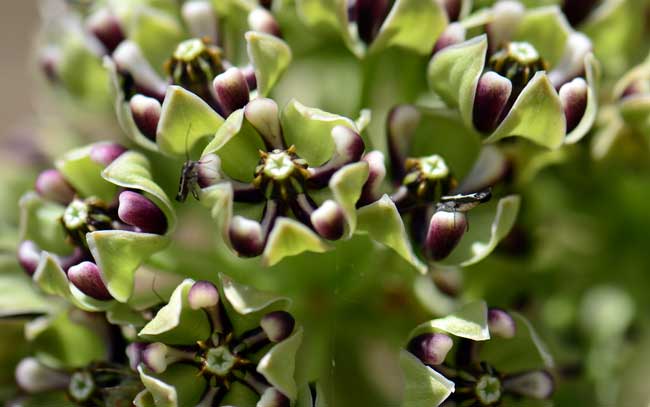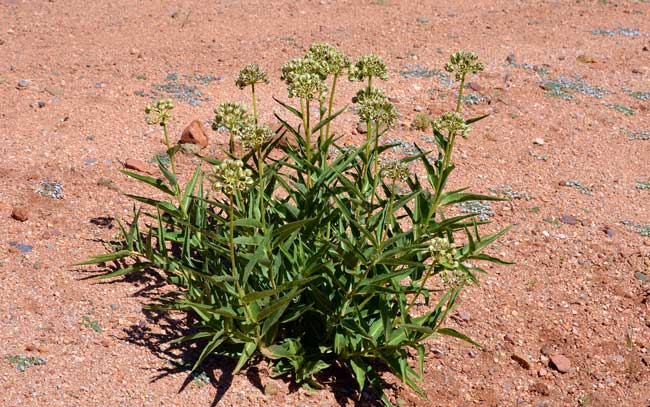Asclepias asperula, Antelope Horns Milkweed




Scientific Name: Asclepias asperula
Common Name: Antelope Horns Milkweed
Also Called: Antelope Horns, Antelopehorn Milkweed, Green-flowered Milkweed, Milkweed, Spider Antelope-horns, Spider Milkweed; (Spanish: Hierba Lechosa, Talayote)
Family: Asclepiadaceae, Milkweed Family
Synonyms: (Asclepias capricornu ssp. asperula)
Status: Native
Duration: Perennial
Size: 1 to 2 feet.
Growth Form: Forb/herb, subshrub; erect or ascending, multiple stems, fine pubescence.
Leaves: Green; more or less alternate, short petioles, leaf shape lanceolate or linear lanceolate, leaves long, 4 to 8 inches, irregularly arranged in 3’s, folded along midrib.
Flower Color: Greenish-yellow with maroon; flower clusters 3 or more inches wide, terminal on branch, fruit is a seed pod called a follicle.
Flowering Season: April to August.
Elevation: 3,000 to 9,000 feet.
Habitat Preferences: Dry plains and slopes, openings in pine forests.
Recorded Range: In the United States Antelope Horns Milkweed is found in the greater southwest part of the country and Idaho; AZ CA, CO, ID, KS, NE, NM, NV, OK, TX, UT and northern Mexico.
North America & US County Distribution Map for Asclepias asperula.
U.S. Weed Information: No data available.
Invasive/Noxious Weed Information: No data available.
Wetland Indicator: No data available.
Threatened/Endangered Information: No data available.
Genus Information: In North America there are 76 species and 91 accepted taxa overall for Asclepias. World wide, The Plant List includes 215 accepted species names and includes a further 122 infraspecific rank for the genus.
In the Southwestern United States: Arizona has 29 species of Asclepias, California has 18 species, Nevada has 13 species, New Mexico has 26 species, Texas has 38 species, Utah has 17 species. All data is approximate and subject to taxonomic changes.
2 subspecies in Asclepias asperula:
Asclepias asperula ssp. asperula, Spider Milkweed; and
Asclepias asperula ssp. capricornu, Antelopehorns.
Both subspecies found in AZ.
Comments: Antelope Horns Milkweed is an attractive plant with large and bold flowers often visited by bees, butterflies and other insects. As is the case for many milkweeds, Antelope Horns Milkweed is a host plant for the Monarch and Queen Butterflies providing a great food source for their larvae caterpillars.
The common name Antelope Horns is reflective of the maturing seed pods which begin to curve as they grow and soon resemble "antelope horns".
Also see in Southwest Desert Flora; Arizona Milkweed, Asclepias angustifolia, Mexican Butterfly Weed, Asclepias curassavica, Dwarf Milkweed, Asclepias involucrata, Pineneedle Milkweed, Asclepias linaria, Rush Milkweed, Asclepias subulata and Horsetail Milkweed, Asclepias subverticillata.
See ethno-botanical uses at Native American Ethnobotany, University of Michigan, Dearborn.

